
Preliminary Tax can come as a bit of a surprise for those who are new to self-assessment. That’s because it’s actually paid in advance of the following tax year, meaning you’ll pay tax on income you’ve not yet earned. To understand your obligations, let’s take a closer look at how Preliminary Tax is calculated so you can ensure you’re not caught out.
What is Preliminary Tax?
Preliminary Tax is an estimate of the tax that you expect to pay for the current tax year. It combines your Income Tax (IT), Pay Related Social Insurance (PRSI) and Universal Social Charge (USC) in one payment.
Unlike pay as you earn (PAYE) employees whose tax is deducted at source, those subject to self-assessment don’t pay tax every month. Instead you’ll be obliged to make a one-off payment each year by calculating your own tax return. This requires you to estimate and pay your tax for the current tax year and settle any outstanding balance for the previous year.
How is Preliminary Tax calculated?
There are three options for calculating your Preliminary Tax. You can pay:
1. 90% of your current year’s liability
2. 100% of your previous year’s liability
3. 105% of your pre-preceding year’s liability
Given that the deadline for payment is 31st of October, you won’t know the full amount of your income for this tax year as it’s not over yet. That can make it tricky to estimate your liability for the current year.
For this reason, the simplest and most popular option is to pay 100% of your previous year’s tax.
Plan ahead to avoid surprises
If you’re new to self-assessment tax or recently set up a new business, this can come as a bit of a shock. It might feel like you’re paying double the tax.
For instance, if the tax liability for your first year in business was €1,000, you’ll be expected to settle that bill and pay Preliminary Tax of the same amount for the current tax year.
Bear in mind, however, that once up and running, things will get easier. The following year, you’ll only have to pay the balance of tax due, plus Preliminary Tax for the current tax year.
From the second year of assessment, ‘double liability’ ceases to be an issue, but you’ll still need to ensure you have a lump sum at the ready for the October deadline.
Calculating your liability as accurately as possible and putting funds aside for Preliminary Tax can really help to manage your tax efficiently. If you’re not sure how to estimate your liability, there’s plenty of advice out there from tax specialists. Check out this handy guide from Tax Return Plus for more information.
Self-assessment taxpayers are required to file and pay their outstanding tax liability, plus Preliminary Tax, by the 31st October, each year.
Beware of penalties
As the Revenue Commissioners makes clear, late payments will be charged interest for each day (or part of a day) past the deadline. Interest is charged at a daily rate of 0.0219% and in addition to this, there may be a surcharge of 5% to 10% applied to your account.
Obviously, it’s best to avoid penalties by paying your tax liability on time and in full. To help you do this, it’s sensible to put money aside in advance, thereby ensuring you’ll have adequate funds at the ready.
By keeping on top of your Preliminary Tax in this way, you can avoid any nasty surprises when it comes to settling your tax bill in October.

















